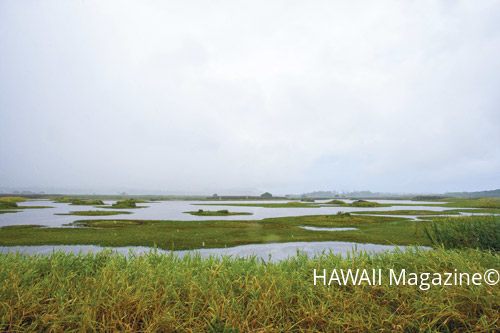Campbell’s Coup: Exploring Oahu’s James Campbell National Wildlife Refuge

Charles van Rees holds a small canvas sack to his chest gingerly as he steps into a sparse office trailer at the James Campbell National Wildlife Refuge on Oahu’s North Shore.
“This is a really mellow one,” says the Tufts University doctoral student, motioning his chin toward the catch bag. Inside is an endangered alae ula (Hawaiian moorhen). Its distinctive red crown, he explains, identifies the bird as an older male.
Rees delicately secures plastic and metal tracking bands around the bird’s spindly legs before measuring, weighing and tucking it back into the catch bag. He sets the bird free in the shallow pond where he caught it, and watches as it disappears into a thicket of high grass and back into the refuge.
On an island once populated by many natural marshes since decimated or threatened by development, endangered Hawaiian waterbird species like the ‘alae ‘ula have found a home in the James Campbell National Wildlife Refuge’s 1,100-acre oceanside expanse. Established in 1976 by the U.S. Fish and Wildlife Service for the protection of waterbirds—on acreage once used by shuttered-in-1971 Kahuku Sugar Mill as settling ponds for washing sugarcane—the refuge is now also home to endangered seabirds, migratory shorebirds and native plant species.
Four species of endangered endemic waterbirds—the alae ula, aeo (Hawaiian stilt), alae keokeo (Hawaiian coot) and koloa maoli (Hawaiian duck)—have flourished here in numbers seen nowhere else in the Islands. Hawaiian monk seals and honu (green sea turtles) are now frequent visitors to the refuge’s pristine, undeveloped coastline. In early 2014, a pair of nene (Hawaiian geese) showed up unexpectedly at the refuge and hatched two goslings. The once-endangered endemic Hawai‘i state bird can be seen in the wild on the Big Island, Maui and Kauai, but the nene pair at Campbell refuge was the first to nest on Oahu since the 1700s.
“When I’m swashing around in the wetland, I really can’t help but get the feeling that what I’m seeing is Oahu as it was, pre-Western contact,” says Rees, who is researching the movement pattern of the alae ula at the refuge as part of his doctoral studies. “This is really the environment that all of these endangered waterbirds evolved for. Without it, they’re really at risk.”

Despite the awe Campbell Refuge instills in biologists like Rees and local birders, its existence is surprisingly little-known, even among longtime Oahu residents. You won’t find it in many travel guides or Oahu “must-see” lists for visitors. The refuge—named after noted 19th-century Hawaii industrialist and landowner James Campbell, whose estate once owned the acreage—is accessed solely by a narrow road off Kamehameha Highway, between the small town of Kahuku and the Turtle Bay Resort, and identified only by a small sign. Public access to the fragile wetlands has always been limited.
The U.S. Fish and Wildlife Service is currently offering guided public tours on Saturdays at 9:30 a.m. through Feb. 28. Tours are capped at 30 people each, who must call ahead to reserve spots. (The refuge is usually closed to the public from March through September for breeding and fledging season.)
The visitor restrictions protect the refuge’s fauna and flora and ensure its fragile ecosystem isn’t overwhelmed by foot traffic. Kenneth Griggs, acting project leader for the Oahu and Maui National Wildlife Refuge Complexes, says the U.S. Fish and Wildlife Service supports public access but makes preserving the refuge habitat its priority.
“These species have been pushed to the brink of extinction through the loss of wetland habitat and the introduction of exotic predators,” says Griggs. “There are very few places left in the Hawaiian Islands that have the habitat native water birds need.”
On a cool June morning, Griggs leads me along winding grass paths and footbridges offering up-close views of the refuge’s Hawaiian marsh ecosystems. He explains that, though natural, the wetlands require human maintenance. The USFWS employs a three-person staff at Campbell and two other preserves on Oahu specifically for trapping predators—such as feral cats and mongoose—controlling invasive plants and maintaining a complex system of aquifers that ensure water levels in the refuge’s central marshes are kept at the right levels: neither too deep, nor too shallow.
At Campbell Refuge, flocks of endangered birds rarely seen on more people-crowded Hawaii shorelines are everywhere, even foraging on a recently mowed lawn. Hold still in one location for a bit and your patience will be rewarded with the appearance of baby waterbirds venturing out into the shallow waters.
Wetlands such as those at Campbell Refuge were once ubiquitous on Oahu. Waikiki and much of the landscape mauka (towards the mountains) of the world-famous resort area were once large marshes, drained at the turn of the 20th century to make way for development. As wetlands disappeared, Hawaiian waterbird populations began to plummet.

The alae ula was one of these species. By the 1940s, there were only about 50 Hawaiian moorhen left in the wilds of Oahu and Kauai. Today, thanks in no small part to efforts at the James Campbell National Wildlife Refuge, the population of alae ula on Oahu—with Kauai, still the only two places on Earth where the species is found—is believed to be around 500.
Campbell’s Saturday tours are guided by a volunteer staff dedicated cadre of birders who believe strongly in the power of education to protect natural places. Longtime volunteer tour leader Dick May explained to me his belief that people are more likely to take ownership of the act of preservation if they can see what they’re protecting.
“If you have a refuge that has public support, then the refuge stays,” he says. “[Campbell] offers the kind of tourism that doesn’t cost a lot and something different than shopping at a mall.”


